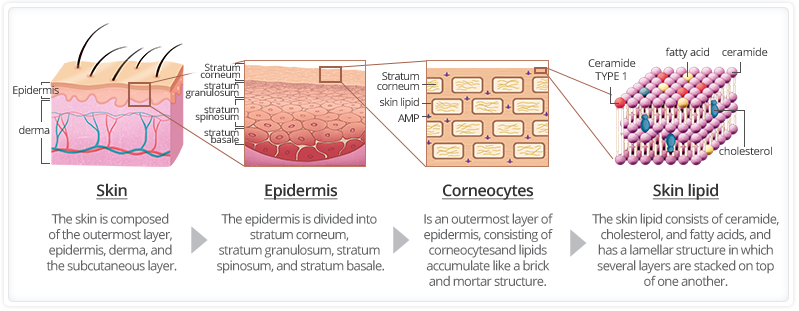| Skin Structure



Skin plays an important role not only in improving a person’s appearance, but also in protecting and enhancing one’s health.
A person’s body consists of about 70% water As such, if the skin does not maintain proper moisture content in the body, it can be life-threatening. In addition, skin blocks the infiltration to the body of harmful elements from the external environment. Here, the skin barrier plays the role of keeping the skin healthy and preventing compounds inside the body from mixing with those outside the body. Therefore, the role of the skin barrier is highly important.
If cement plays the important role of connecting bricks to build a firm wall, Corneocytes(dead skin cells) and lipid compounds strengthen the skin barrier by filling in the spaces in between the corneocytes(dead skin cells) at the outermost layer of the skin.
Skin ceaselessly regenerates throughout a lifetime and maintains a certain level of thickness and its functions. Cells generated inside the skin eventually become corneocytes(dead skin cells), and these fall off every four weeks. On the stratum corneum, not only corneocytes(dead skin cells) exist, but also skin lipid, which binds cells as explained earlier.
Lipid, like oil, does not mix with water, and is tightly and meticulously aligned on stratum corneum to prevent moisture loss as well as the infiltration of harmful elements to the body. Observing the lipid structure of the stratum corneum using an electronic microscope shows a particular structure of several layers aligned in parallel.
Such lipid structure is called a lamellar structure. Because several layers of lipid, which does not mix with water, are aligned in parallel, water and other harmful elements from the external environment do not easily penetrate the skin.
The skin type that is representative of a damaged skin barrier is dry skin. In dry skin, water is easily lost, leaving the skin drier and vulnerable to the infiltration of harmful elements from the external environment, thereby causing irritation or allergies. Of the several hundred lipid compounds inside dry skin, ceramide is particularly lacking. Skin that lacks ceramide does not show a normal lipid lamellar structure.
Both dry skin and sensitive skin lack ceramide or have an abnormal lipid structure. Lack of ceramide causes various skin problems. As such, several attempts have been made to develop products that supply enough ceramide to the skin in order to improve the function of the skin barrier. However, supplementing ceramide ingredients alone cannot help the lamellar structure inside the stratum corneum efficiently recover. A moisturizer with a lamellar structure can help the skin barrier better recover its function.